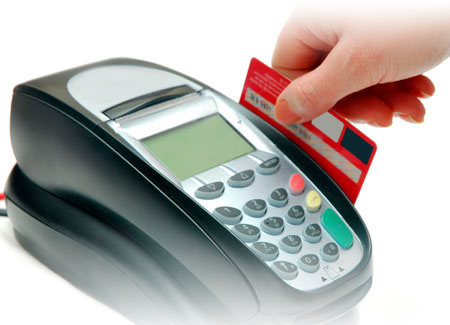Interchange
 Interchange is a fee that the Credit Card Associations of Visa and MasterCard assess for every payment card transaction processed by participating merchants. The interchange fee is then passed on to the financial institution that had issued the card (Card Issuer) used in the transaction. The card issuer then credits the merchant?ÇÖs account with the merchant’s payment processor (Processor). The credited amount is equal to the transaction amount minus the interchange fee. The interchange is paid during the settlement of the transaction and typically is represented as a percentage rate plus a flat fee.
Interchange is a fee that the Credit Card Associations of Visa and MasterCard assess for every payment card transaction processed by participating merchants. The interchange fee is then passed on to the financial institution that had issued the card (Card Issuer) used in the transaction. The card issuer then credits the merchant?ÇÖs account with the merchant’s payment processor (Processor). The credited amount is equal to the transaction amount minus the interchange fee. The interchange is paid during the settlement of the transaction and typically is represented as a percentage rate plus a flat fee.
For example Visa’s CPS / e-Commerce Basic interchange is 1.80% + $0.10 + 0.0925%. CPS / e-Commerce Basic is Visa’s interchange fee program classification which determines the interchange fee to be applied to each transaction. Currently there are more than 40 different Visa classifications and more than 50 MasterCard classifications.
In the above example 1.80% + $0.10 is the interchange fee that Visa passes directly on to the Card Issuer. This fee varies according to the fee program classification used for each transaction. It is important to understand that the interchange fee program is affected by several factors. Most important among them are the type of card (debit, credit, rewards, business-to-business, etc.) and completeness of provided transaction information.
The 0.0925% portion of the above interchange example is the Dues & Assessment Fee charged by both Credit Card Associations for each transaction processed through their networks. MasterCard’s Dues & Assessment Fee is currently at $0.095%. The Dues & Assessment Fee is the same for each transaction and is not affected by the interchange fee program classification.
The interchange fees are updated twice a year, in April and October and are available on Visa’s and MasterCard’s websites.
Optimizing Interchange in Card-not-Present Environment
Organizations operating in a card-not-present environment should always apply the following best practices to ensure securing the most advantageous interchange fee:
- Use the Address Verification Service (AVS) for each transaction. AVS enables merchants that accept card-not-present transactions to compare the billing address (the address to which the Card Issuer sends its monthly statement for that account) provided by a customer with the billing address on the Card Issuer’s file before processing a transaction.
- Provide service or ship product within seven days of the authorization.
- Include the original transaction ID from your authorization in your settlement or refund transaction.
Interchange-Plus Pricing vs. Tiered Pricing
Interchange-plus is the pricing structure where processors add a surcharge to the interchange fee charged for each card transaction. This surcharge is the fee the Processor charges for providing processing services to the merchant. The Processor does not share in the interchange rate which is collected exclusively by the Card Issuer. The surcharge remains the same for all interchange fee program classifications, thus ensuring that the Processor charges the same fee for each transaction. For example, a Visa card transaction that received a CPS / e-Commerce Basic is interchange fee program classification will be processed at 1.80% + $0.10 plus the Processor’s surcharge. If the surcharge is 0.45% + $0.15, the merchant will be charged a total of 2.25% + $0.25 for the transaction. If the card was a Visa rewards card and received a CPS / Rewards 2 classification, the interchange fee will be 1.95% + $0.10. The Processor?ÇÖs surcharge will still be 0.45% + $0.15 and the total – 2.40% + $0.25.
Processors that use the much more prevalent tiered pricing charge one fee for “Qualified Transactions” and another for “Non-Qualified Transactions.” Sometimes Processors use another qualification tier called “Mid-Qualified Transactions.” Processors charge “Qualified” fees for transactions processed in a manner that exactly matches the description provided by the merchant when the merchant’s credit card processing account was set up. For example, if the merchant had stated in its application for a processing account that it will be processing consumer types of cards over the internet, the transaction will be classified as a “Qualified Transaction” and processed at the most advantageous rate, e.g. 2.25% + $0.25. However, if the card was a rewards card, the transaction will be classified as a “Non-Qualified Transaction” and the merchant will be charged a higher rate, e.g. 3.25% + $0.25. The Processor will establish in the Merchant Processing Agreement the exact criteria that will be used to classify each transaction.
It is important to understand that in a tiered pricing structure the Processor needs to set the “Non-Qualified” rate at a level that is sufficiently high to ensure that no transaction is processed at a loss. As a consequence, the fee that the merchant pays for the Processor fee component of the total processing charge will vary by interchange fee program classification. In the above example, the Processor ends up collecting 1.30% + $0.15 for the rewards card transaction (1.95% + $0.10 is the interchange). However, if the transaction received a Commercial Card Not Present classification by Visa, the interchange fee would be 2.55% + $0.10. The transaction would again be classified as “Non-Qualified” and the merchant would again be charged 3.25% + $0.25 but the processor would collect a smaller fee for its services (0.70% + $0.15).
The tiered pricing model has one advantage over the interchange-plus ?Çô it is simpler and the merchant knows exactly how much it pays for “Qualified” and “Non-Qualified” transactions. The disadvantages, however, far outweigh the advantages. Even though the tiered pricing structure provides concrete rates, it is often difficult to understand the qualification guidelines. Moreover, because the “Non-Qualified” rate needs to be set above 3.00% to ensure that the Processor is not losing money on transactions involving a few high-priced types of business-to-business and purchasing cards, the merchant will end up overpaying for the more widely used rewards cards. A typical eCommerce or MO / TO merchant processes far fewer business-to-business or purchasing cards than it does rewards cards. Additionally, the interchange-plus model ensures that debit cards are processed at lower rates than credit cards, as their interchange rates are substantially lower. A typical tiered model lumps debit cards together with credit cards.
Summary
The interchange-plus pricing model is not simple, as each transaction is settled not at a pre-defined rate but at a rate that is equal to the sum of the interchange fee that the Credit Card Associations charge plus a fixed service fee that the Processor charges. Yet, given that the interchange fees are determined by Visa and MasterCard and that neither the Processor, nor the merchant has any influence over it, the only fee that can really make a difference, is the Processor’s service fee. The examples above show how widely the Processor’s fee can range in a tiered pricing model. The interchange-plus model offers the exact opposite, where for each card transaction the merchant is charged the same Processor fee.
When the interchange-plus pricing model is backed by a good reporting solution, merchants can easily see exactly how much the Processor charges for its services. With a tiered pricing model this is rarely possible, as processors typically limit the reporting to showing the number of transactions and processing volumes by qualification groups. When a Processor submits a pricing proposal to a merchant, the only meaningful way to compare it to the current pricing structure is to compare the proposed Processor’s fees to the current one’s. Because it is not always easy to estimate these costs, we recommend that once a year merchants conduct an independent audit of their payment processing services.
![]()
















